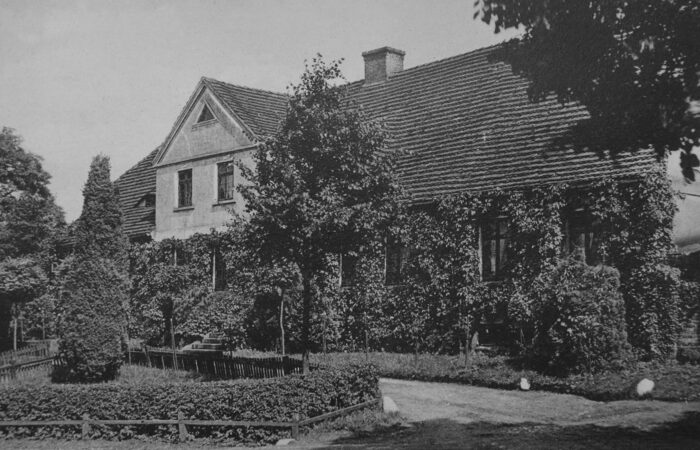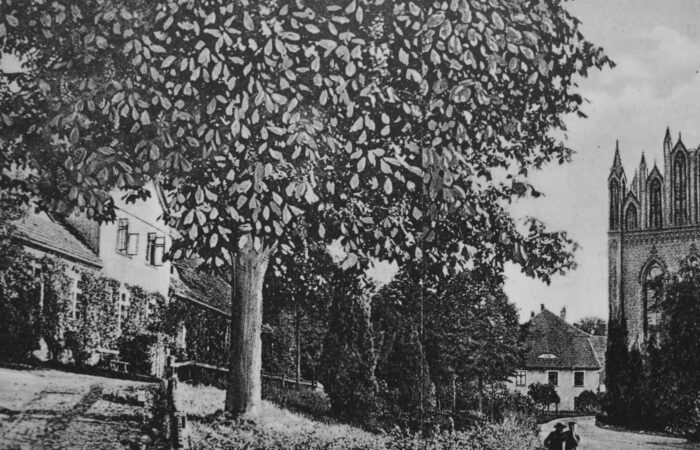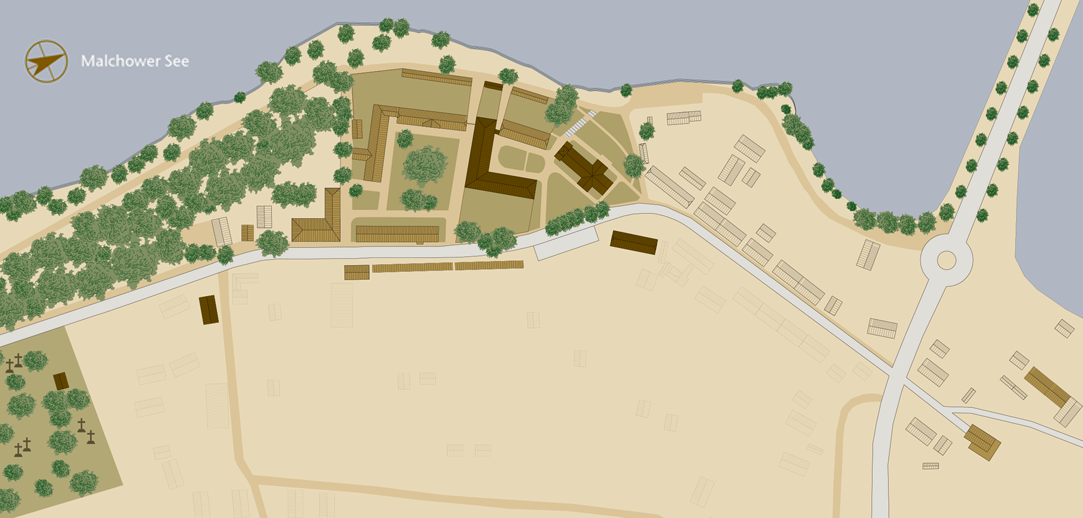
- Home
- 07_Parsonage
 Parsonage | around 1900
Parsonage | around 1900 Parsonage | around 1900
Parsonage | around 1900 Aerial view of Malchow Monastery | around 1942
Aerial view of Malchow Monastery | around 1942 Building development of the parsonage
Building development of the parsonage
The Parsonage
Malchow Monastery
Parsonage
SHOW THE TEXT
The church patronage for Old- and New-Malchow, as well as for the church in Lexow, was part of the foundation endowment of the medieval monastery. Thus, the monastery had not only a significant influence on the use of the respective parish privileges, but was also responsible for all church buildings in the town of Malchow, such as the church, vicarage and school. Until 1825, the second pastor of the town church was responsible for the monastery community, including the secondary church in Lexow, which was known as the affiliate church. With the creation of a separate parsonage for the monastery, the need for a second pastor at the town church was eliminated.
The two houses, which had previously been used as a school and organist house and as an apartment for the police officer, were combined into a single building. The typical late baroque semi-detached house from the late 18th century became the vicarage – directly opposite the monastery church, which also functioned as a parish church. The school building was relocated to the opposite side of the street, being then established in an existing residential building.
With the conversion, the building received its classical appearance. It is characterized by the representative dwelling in the middle. There is a dormer-like structure on the roof, the gable of which is flush with the facade.
The parsonage underwent another change and enlargement in 1867 and 1888 with an extension to the southern gable, and has remained unchanged since that time. At the rear was the parish garden, which was mainly used as a kitchen garden for the care of the pastor’s family.
Owned by the town of Malchow since 1997, the old rectory became the organ house. It is owned by the Mecklenburg Organ Museum together with the monastery church. The building houses not only exhibition rooms, but also the workshop, the museum library and the store.
Parsonage
The church patronage for Old- and New-Malchow, as well as for the church in Lexow, was part of the foundation endowment of the medieval monastery. Thus, the monastery had not only a significant influence on the use of the respective parish privileges, but was also responsible for all church buildings in the town of Malchow, such as the church, vicarage and school. Until 1825, the second pastor of the town church was responsible for the monastery community, including the secondary church in Lexow, which was known as the affiliate church. With the creation of a separate parsonage for the monastery, the need for a second pastor at the town church was eliminated.
SHOW THE WHOLE TEXT
The two houses, which had previously been used as a school and organist house and as an apartment for the police officer, were combined into a single building. The typical late baroque semi-detached house from the late 18th century became the vicarage – directly opposite the monastery church, which also functioned as a parish church. The school building was relocated to the opposite side of the street, being then established in an existing residential building.
With the conversion, the building received its classical appearance. It is characterized by the representative dwelling in the middle. There is a dormer-like structure on the roof, the gable of which is flush with the facade.
The parsonage underwent another change and enlargement in 1867 and 1888 with an extension to the southern gable, and has remained unchanged since that time. At the rear was the parish garden, which was mainly used as a kitchen garden for the care of the pastor’s family.
Owned by the town of Malchow since 1997, the old rectory became the organ house. It is owned by the Mecklenburg Organ Museum together with the monastery church. The building houses not only exhibition rooms, but also the workshop, the museum library and the store.
Mecklenburg Organ Museum
The Mecklenburg Organ Museum has been located in the Malchow monastery church and in the vicarage since 1997. It preserves and displays vulnerable instruments from the Mecklenburg area. In addition, it is dedicated to researching and, with its extensively preserved organ inventory, presenting the history of organ building in Mecklenburg.
SHOW THE WHOLE TEXT
A model shows how the instrument works and at the same time offers visitors the opportunity to play the organ themselves. Several organs and their tonal peculiarities are presented in guided tours.
The museum houses organs and organ parts that were threatened with dereliction in their original location. As a rule, they are given to the museum as loans. In this case, no restoration takes place, only cleaning and conservation. Depending on the state of preservation, the instruments are also made playable again. The acoustic conditions inside the monastery church are excellent for organ music. The museum offers the rare opportunity of hearing up to ten different organs in the same room. In the guided tours available, various organs are always demonstrated.
In addition to the main exhibition room in the monastery church, there are other exhibition rooms in the former parsonage on the opposite side of the street. The library, workshop and store are also housed there.
Organ research and the preparation of an organ inventory are concentrated on the historical area of Mecklenburg. The museum has an extensive specialist library. This also includes more than 1,000 different hymn books and a collection of around 600 vinyl records featuring the organ. These collections can be utilised by prior appointment.
Special highlights are the summer concerts from July to September with the series of Sunday organ matinees.


Embankment

Laundry

Hospital

Smithy

Bulwark and Promenade

Church

Parsonage

Cloister Courtyard

Refectory

Dormitory

Deaconess's house

Wall Garden

Ladies' Retreat

Terraced Houses 1

Kitchen Master’s House

Terraced Houses 2

Administration Building

Jail

Barn terraced houses
and farm yard

Engels Garden

Monastery Cemetery

Cemetery Chapel

Burial Ground of the Conventual

Cartwright's Workshop
SHOW ALL OBJECTS
Embankment
Laundry
Hospital
Monastery Smithy
Bulwark and Promenade
Monastery Church
Parsonage
Cloister Courtyard
Refectory
Dormitory
Deaconess's house
Wall Garden
Ladies' Retreat
Terraced Houses | 1
The Kitchen Master’s House
Terraced Houses | 2
Administration Building
Jail
Terraced stable houses and farmyard
Monastery Cemetery
Cemetery Chapel
Burial ground of the conventuals
Cartwright's Workshop
Exact location in Google Maps

Mit dem Laden der Karte akzeptieren Sie die Datenschutzerklärung von Google.
Mehr erfahren
